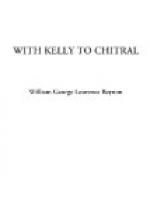We officers slept in the fort that night, four or five of us in a room. Mastuj is of the ordinary type of country fort, square, with a tower at each end and one over the gateway, curtains between each tower about eighteen to twenty feet high, and the towers another fifteen feet higher still. The whole place is built of layers of stones and wood plastered together with mud, while there is generally a keep or citadel inside which commands the rest of the fort, and in which are the governor’s and women’s quarters. In Mastuj, of course, we used these as officers’ quarters. The whole fort is a horribly dirty and tumble-down old place; the roof of the officers’ quarters had to be propped up, as it was considered unsafe, and I quite believe it. The rooms had the usual hole in the roof for the smoke to get out at, but Moberly had erected a stove in his room, which was a great improvement.
CHAPTER VI
THE RECONNAISSANCE FROM MASTUJ
While at Mastuj we heard from Jones the story of the disaster at Koragh—which I will give.
Ross, with Jones and about ninety-three Sikhs, left Mastuj on the 7th March, with the intention of helping Edwardes and Fowler, who were believed to be in danger at Reshun, and marched to Buni; leaving a detachment there of thirty-three sepoys under a native officer, he marched with Jones and sixty men for Reshun, hoping to arrive there that day.
After leaving Buni, the road runs for some distance along flat ground until the junction of the Turikho and Yarkhun rivers is reached. At this point the road leads up along the face of a cliff and then down on to a small plain, where are a few houses and some patches of cultivation. This is known as the village of Koragh, and immediately after, the river runs between the cliffs, which draw together and make the mouth of the defile. The path which follows the left bank crosses the debris fallen from the cliffs above and then runs along the edge of the river at the foot of another and smaller cliff, or in summer, when the river is full, the path runs over this smaller cliff. Ross’s party took the lower road. After the second cliff the paths lead on to a small plain about two hundred yards wide at its greatest width, and perhaps half a mile long, and then runs up and across the face of a third cliff which drops sheer down into the river. This cliff forms the end of the trap. It would be hard to find a better place for an ambuscade.
Ross’s advance guard was on this plain, approaching the spur which closes the trap, when they were fired on. Ross went forward to reconnoitre the ground, and at once saw the impossibility of driving the enemy out with his small force, and therefore ordered Jones to go back and hold the entrance of the defile to enable them to escape. On the first shot being fired, the coolies had chucked their loads and bolted, as likely as not helping to man the sangars enclosing the party. Jones, taking ten men, made an attempt to reach the mouth of the defile, but found it already occupied by the enemy, who had run up stone sangars, and by the time he had got within a hundred yards of it, eight of his ten men were wounded. He therefore fell back on the main party, who had taken refuge in some caves at the foot of the cliff.




